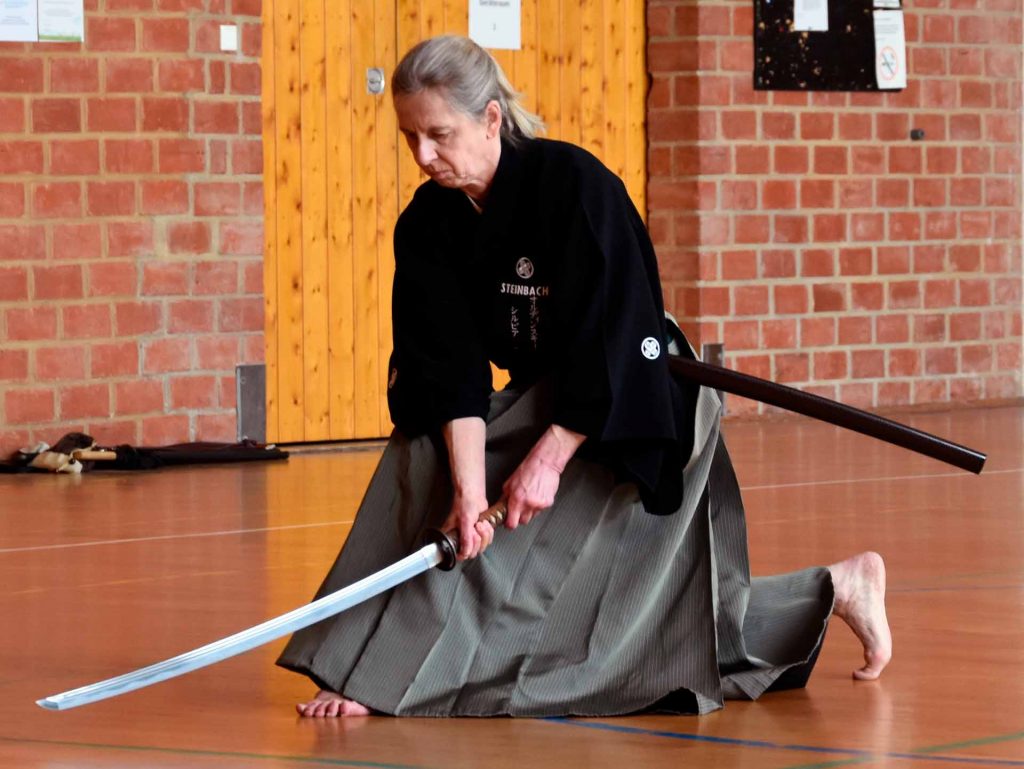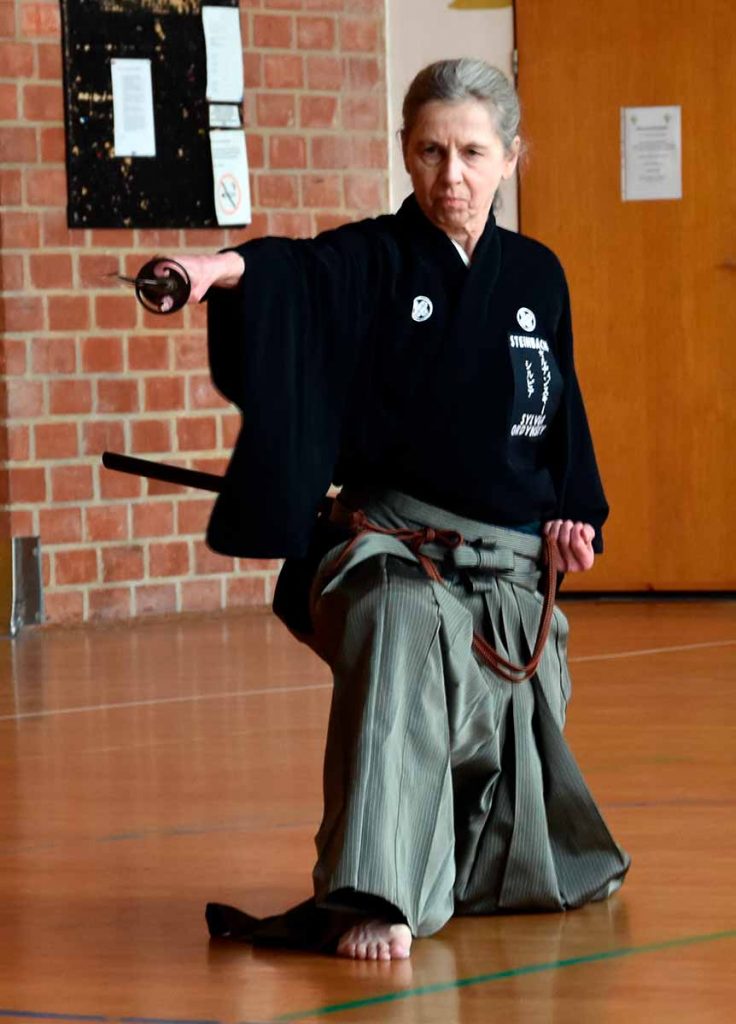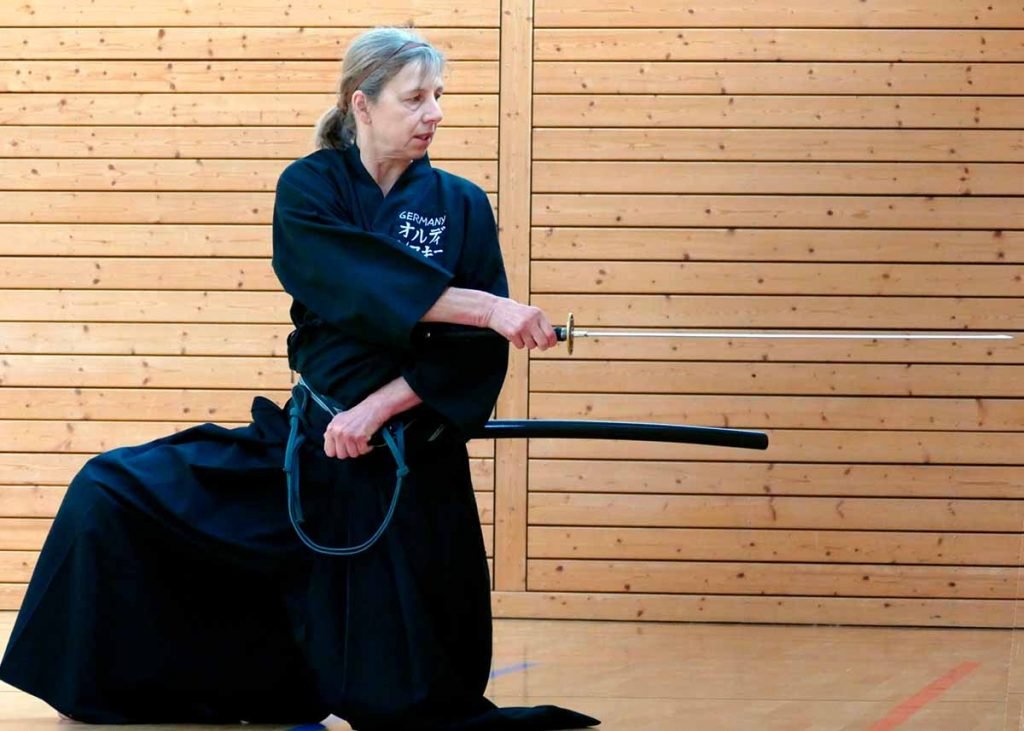Versione Italiana qui
Sylvia Ordynsky Sensei is a German budoka with whom we continue our fascinating European history of iaido. 5th dan of Aikido, kyoshi 7th dan of Iaido, having been able to learn the art of the sword in Japan, she had the not too common opportunity to study with a hanshi iaido 9th dan, as the late Sagawa Sensei. From the first experiences of teaching by invitation, to trips to Japan, to the return to Germany, through anecdotes of personal and martial life, today we retrace the fundamental stages of another historical key figure in the development of European iaido through the Kiryoku interviews with the great western masters.

Ordynsky sensei, first of all thank you for accepting our invitation and for taking a little time to track your story back and to allow us to offer european iaidoka a picture from the origins to nowaday.
Let’s start as always from the principle in order to better frame the sensei in the historical moment and in the properplace: when were you born and what is your job?
I was born on June 17th, 1957 in Wedel, near Hamburg, Germany. As a technical employee in the pharmaceutical industry, I worked in instrumental analytics but I’m now retired.

If i don’t remember wrong you also practiced other martial arts: to provide our readers a more complete picture of you, would you tell us how your martial career started and what grades you reached?
I started with Aikido in Darmstadt in 1973, when I was still at school.
Because of a demonstration (enbu) with Kendo and Iaido, my interest in learning more about the Japanese sword grew, especially since Aikido is also practiced with bokken.
When I saw those enbu, it was not clear what exactly was being demonstrated, because the information and translation was extremely sparse. Later, through an older Budoka
I was able to initiate contact with an English-speaking/writing Japanese woman in Tokyo.
This was a stroke of luck and I am very grateful to my pen pal at the time for later opening the door for me into a Japanese dojo in Tokyo.
I was curious and motivated to learn and feel it more of a task and less of an obligation.
Now I am 5th dan Aikido and 7th dan Iaido kyoshi.

A life dedicated to the art of the sword, a true passion. From what i understood the beginnings were not certainly easy, due to the lack of information and schools. What actually was iaido dojo scenario when you started to practice?
Aikido was practiced in a gym, Iaido was still quite unknown. I had always experimented alone in the flat (ceiling height > 3m) in the beginning and later practiced in a barn. The first real dojo was the Hakushinkan-dojo of Sagawa Sensei in Tokyo/Setagayaku. This was traditionally furnished in a family house on the ground floor with kamiza opposite the entrance, it had a sprung floor with thick wooden boards which over the years were no longer smooth but somehow “alive” with furrows and knotholes. It was quite small, with a maximum of six Iaidoka practicing with shinken at the same time. People took turns, some sat on the edge and watched the practitioners.
There were two large mirrors behind sliding doors, shelves full of Kendo equipment and racks of bokken and shinai.

Let’s also dive a little bit into the personal approach to iaido, to its philosophy: what iaido represent to you, what is its meaning and what did it offer you across your life long deep experience?
It is said that one grows with one’s tasks and, parallel to this, knowledge and experiences grow in many respects. Iaido 20 years ago had a different meaning and emphasis for me than it does now. In the past, it was very important for me to practice the kata in detail, to move in the same way as Sagawa Sensei. But I realized that it’s not just about copying the Sensei, that’s 100% impossible. Now I see more spiritual and historical aspects as important and see the sword as such as a constant in the path of life. To connect spiritually with the sword, to enter into a symbiosis like a musician playing the harp or piano. This is how I continue to work on “ki ken tai no ichi”.

Talking about sensei, you also told us something about your experiences in the sagawa sensei dojo: would you like to tell us something more about this great iaidoka, his heritage, and who is your sensei today?
As previously indicated in answer two, I had the opportunity to be introduced to Okada Sensei during a teaching session. At that time, Okada Sensei was sitting on a chair and apparently lecturing some students sitting in front of him in seiza quite loudly, so I was a bit startled,
which my friend noticed and when she said: look, Sagawa Sensei is just coming in the door and in his dojo I could also start.
I immediately replied: yes, I just want to go to Sagawa Sensei.
Sagawa Hakuo Sensei 9.dan Iaido Hanshi (Muso shinden ryū), Kendo 8.dan Kyoshi.
Thus developed a teacher-student relationship from 1979-2004. On 16.12.2004 my highly esteemed teacher (shisho) passed away.
I then became a student of Soejima Manabu Sensei, Iaido 8.dan Kyoshi.
Sagawa Sensei had already introduced Soejima Sensei as his successor in Germany in July 2000 in Berlin.
After Soejima Sensei died on 11.07.2015, I became a student of Furuichi Norio Sensei, Iaido 8.dan Kyoshi, Kendo 7.dan Kyoshi, 7.dan batto, 6.dan Tankendo, 6.dan jukendo, 3.dan Jodo.

I think i, together with all of our readers, cannot be more curious about how the connection with a 9th dan sensei can be, as this is very rare in these days, so we definitely need to know more about.
All the years I spent my holidays in Tokyo and trained under Sagawa Sensei in the Hakushinkan-dojo were always marked by a very personal and familiar relationship with Sensei and his whole family.
Sagawa Sensei gave me a brown obi and a notebook in the beginning, with the instruction to always take notes. For his foresight in many things, I am grateful to him from the bottom of my heart.
Almost all day I was in the dojo with Sensei and was often invited to lunch at the flat. The morning training on Tuesday ended with a communal breakfast. Everyone brought something and Mrs. Sagawa poured us tea before everyone went to work, but I then continued practicing in the dojo. I was also allowed to accompany sensei to courses in other cities. My private accommodation was only a few minutes’ walk from the dojo.
Soejima Sensei’s classes were usually held in a gymnasium, which he reserved accordingly.
With Furuichi Sensei, I could attend general classes or in the mornings, with other foreign students in his dojo.

I understand that your stay in japan was quite frequently, but how did this adventure begin as a foreign student in their dojo and do you still train in Japan today?
As a German, I seemed very welcome in 1979, but was often asked if I was from the US.
The last time I trained at Furuichi Sensei’s dojo was in 2018 had always been very kindly cared for and taught there.
Therefore, I felt like a member of the dojo and not a foreigner.

Furuichi sensei has collected a massive experience and impressive number of dan grades in many martial arts and the relationship between all these disciplines is definitely constructive for any practicioner. Could you describe how different martial arts contributed and influenced your personal and general development of budo?
In Aikido you practice with a partner who takes on the role of the attacker. When attacking from a distance, e.g. yokomen uchi, aspects and criteria such as ashisabaki, maai and also metsuke are just as important as in Iai. Through a real “opponent” I have a better grasp of these connections as well as action and reaction than if I only practice with an imaginary opponent.
I think that the classical Budo disciplines complement each other and show parallels.
Ueshiba Morihei (OSensei), the founder of Aikido was extensively trained in
e.g. Tenjin shinyo ryū jujutsu, daito ryū, Yagyu shinkage ryū, kenjutsu.
In Iaido the handling of the sword, in Aikido physical training has a priority, but both are connected with the defensive character of the Budo.

Movig from the student’s perspective to the teacher’s, are there differences between the japanese and western teaching model? For you who have studied a lot in Japan, was it necessary to make any change to grant european students a better experience?
Under Sagawa Sensei I practiced and followed a kata or detail for longer.
Hints, corrections or explanations were concise and to the point. The method was more learning through attentive observation, also due to language problems.
I myself change the subject or kata more quickly, at least with the advanced students.
I also have the advanced students practice in pairs to improve each other’s kata and to increase their understanding of the ZNKR-criteria.

Would you like to recap your teaching path since the beginning? When did you host your first lesson ever?
At the request of an Aikido-dojo, I conducted my first course as a shodan in 1983.
I had no teaching experience at the time, but of course I tried to show and explain everything as well as possible in the spirit of Sagawa Sensei. At that time, most of the training was done with bokken, as only a few people had an Iaito. Further invitations followed.
After a one-year stay in Tokyo and daily training in the Hakushinkan-dojo, I found a new job near Frankfurt a.M. I taught in Frankfurt for a short time, then turned to another club with better training conditions and so I have been teaching in the club TUS Steinbach e.V. Hakushinkai in Steinbach since about 1991.

You really had a lot of experiences as a student and as a teacher, so you must have joined different groups, by age or experience: is there any preference of yours toward a specific class you particularly love teaching because of their unique requirements?
I have no special preferences for certain groups. Whether young or old, beginner or advanced, I see it as my task to adapt to the respective group or individual Iaidoka, to give further exercises and explanations, and also to practice one or the other kata together.

As a person changes through the years, also experience changes accordig to one’s own growth. Has anything happened to the discipline itself? I mean, has iaido changed over the years and how?
I cannot answer this question objectively either, as it is too complex. However, I would like to draw attention to a tendency that may affect younger Iaidoka.
For about 15 years now, those who want to learn Iaido in Europe have had many more teachers at their disposal than in the past, and also many more videos and other digital information; so knowledge is now imparted to these learners in a much shorter time.
Assuming that the knowledge received in this way is also well understood cognitively, I nevertheless have the impression that the learner then thinks that he or she can physically implement this knowledge immediately and without patience even without guided practice, but that he or she misses this goal most of the time, but without noticing this himself or herself.
Younger Iaidoka in particular are partly influenced by the Japanese pop culture that is becoming more and more influential in Western media. Some popular anime with an often action-based and unrealistic representation of a distorted Japanese culture then serve as motivation to start a traditional budo discipline. Often these Iaidoka are then disappointed at some stage of their training as the traditional way (Do) and the progress that comes with it seems to conflict with the image that is presented by the media.
In many places, practitioners are often seen to have a good technical level, but the substance of the Iaido is not very well developed.
On the other hand, if you look at old videos, they usually do not show the technical aesthetics that can be perceived today; but whether the -spiritual- opponent is defeated or not yet, there is no doubt about it: e.g. Haga Junichi. The physical hitting of the opponent is absolute, even without the swishing sound of the blade during a cut (kirioroshi).
Going to a more restricted level of detail, how is one of your typical iaido lesson organised?
After a short mobilisation and warm-up, I start with ashisabaki and various suburi. Or the sequence of a kata is practiced with bokken and “opponent” to become more aware of the situation you are in. With the advanced students, I then practice koryū, followed by ZNKR-Iai. Beginners practice only ZNKR-Iai in parallel, so I lead 2 small groups in the dojo at times. It is also important for me to explain Japanese technical terms.

Seitei iaido and koryu express different levels of understanding and this also leads us to talking about what is behind the art of the sword: do you think non-japanese iaidoka can really understand the culture and the “philosophy” of iaido?
This is a delicate question, because it presupposes that there is a standard or a definition to be able to judge such things accurately. But I think that it is becoming more and more possible for Budoka who study and engage intensively with the underlying culture and philosophy of Iaidoka to acquire a deeper understanding and knowledge of this.
Japanese Iaidoka have more opportunities to study historical sources, and until half a century ago they mostly grew up in their traditional culture. But this culture has since become increasingly westernised and changed accordingly. Thus, even for the Japanese, their traditional culture and its traditions are by no means always comprehensible. And this can also be noticed physically, for example: In the past, the Japanese sat on the floor in a seiza or at least cross-legged position; nowadays, however, they almost always sit on chairs, just like us.
This is my view of the underlying philosophy of Iaido: Iaido or Budo, which goes beyond the purely technical, is based on the firm and calm attitude of being able to face death with a clear mind and to act accordingly, without trembling and without freezing, and this is independent of one’s background.
Fortunately for us, hardly anyone in this country today finds himself in a situation where he has to fight to the death; and then, of course, we lack the experience that can suddenly lead us to a deeper insight into the way of life.
However, it can also help us to absorb the mantra that we used to know in the past: “Memento mori! Remember that you will die.
From the past to the future, from real fighting to the development of a discipline, what do you think about the future of iaido, specifically the eureopean one?
Just like in Japan, Iaido will somehow continue to change. As long as we maintain good and strong relations with Japan, I assume that we will stay on the right track together.

The path has never been easy for anyone, due to commitments, sacrifices ad those necessary changes accompanying the growth trhough a practice for a whole life. What would you recommend to a young beginning iaidoka who moves his first steps on this path?
In life there are difficult phases from time to time when you cannot practice as much as you would like. Due to studies, family, caring for parents or work, you may not be able to practice for months or even years, but you should start again after such breaks and discover Iai “anew” for yourself. The sword was the lifelong companion of the samurai and also of the knights in Europe.

So, talking about messages to deliver, what have you personally developed as a budo teaching you particularly like transmitting?
Sei sho go sho
正 勝 吾 勝
True victory is self victory.

I always feel sorry to suddenly find me at the end of these interviews because the topics are always so fascinating that time literally flies when listening to the stories of our great senseis. On behalf of Kiryoku i can only thank you again for the time and attention you dedicated us and as usual we like closing with some lighter topic: have you any funny anecdote about your life in iaido that you would like to share with us?
After a class, I went with Sagawa Sensei and his wife to Düsseldorf to do some shopping. So I parked in a multi-storey car park and we did the shopping.
Back in the car park with full shopping bags, I discovered that my car had obviously been stolen during this time. The parking number and also a coloured wall matched! I explained this to Sensei and wanted to notify the police. Sensei asked if this was indeed the right place and I said quite naturally: ” yes, is right”. I then took a closer look at the parking ticket and realized that we were in a parallel street in a very similar car park.
I would have liked to sink into the ground, but Sensei just laughed. Since then, I’ve been particularly attentive when it comes to car parks.













